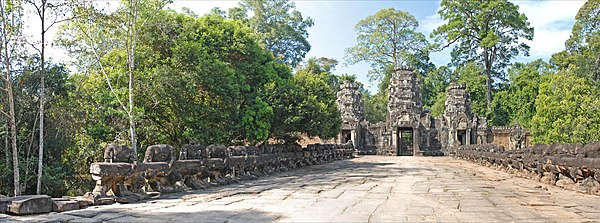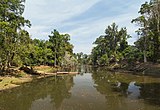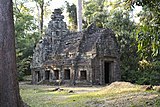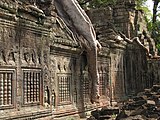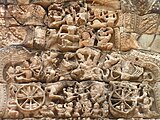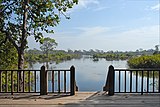Preah Khan
| Preah Khan | |
|---|---|
 | |
| Religion | |
| Affiliation | Hinduism |
| Deity | Vishnu |
| Location | |
| Location | Angkor |
| Country | Cambodia |
| Geographic coordinates | 13°27′43″N 103°52′18″E / 13.4619594°N 103.8715911°E |
| Architecture | |
| Type | Khmer |
| Creator | Jayavarman VII |
| Completed | 1191 A.D. |
| Website | |
| wmf.org/preah-khan | |
Preah Khan (
History
Preah Khan was built on the site of

Preah Khan experienced a slow decline because the Khmer royalty stopped supporting it around the 15th century.[3] As support from the royal family dwindled, it became difficult to maintain and use the complex. Despite this decline, certain sections of the site continued to be used for religious or cultural activities.
The temple is still largely unrestored: the initial clearing was from 1927 to 1932, and partial anastylosis was carried out in 1939. Since then free-standing statues have been removed for safe-keeping, and there has been further consolidation and restoration work. Throughout, the conservators have attempted to balance restoration and maintenance of the wild condition in which the temple was discovered: one of them, Maurice Glaize, wrote that;
The temple was previously overrun with a particularly voracious vegetation and quite ruined, presenting only chaos. Clearing works were undertaken with a constant respect for the large trees which give the composition a pleasing presentation without constituting any immediate danger. At the same time, some partial anastylosis has revived various buildings found in a sufficient state of preservation and presenting some special interest in their architecture or decoration.[7]
Since 1991, the site has been maintained by the
The site
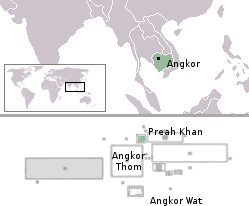
The outer wall of Preah Khan is of
As usual Preah Khan is oriented toward the east, so this was the main entrance, but there are others at each of the cardinal points. Each entrance has a causeway over the moat with nāga-carrying devas and asuras similar to those at Angkor Thom; Glaize considered this an indication that the city element of Preah Khan was more significant than those of Ta Prohm or Banteay Kdei.[10]
Halfway along the path leading to the third enclosure, on the north side, is a

West of the third eastern gopura, on the main axis is a
Connecting the Hall of Dancers and the wall of the second enclosure is a courtyard containing two
Between the second enclosure wall (85 by 76 m or 279 by 249 ft) and the first enclosure wall (62 by 55 m or 203 by 180 ft) on the eastern side is a row of later additions which impede access and hide some of the original decoration. The first enclosure is, as Glaize said, similarly, "choked with more or less ruined buildings".[15] The enclosure is divided into four parts by a cruciform
Microbial degradation
Microbial biofilms have been found degrading sandstone at Angkor Wat, Preah Khan, and the Bayon and West Prasat in Angkor. The dehydration and radiation resistant filamentous cyanobacteria can produce organic acids that degrade the stone. A dark filamentous fungus was found in internal and external Preah Khan samples, while the alga Trentepohlia was found only in samples taken from external, pink-stained stone at Preah Khan.[5]
Photo gallery
-
Moat that surrounds the temple complex
-
Sculptures on the way to the temple
-
Bridge
-
Library
-
Gopura
-
One-story structure at Preah Khan
-
Entrance
-
Interior of the temple
-
Carved lintel
-
Jayadevi, one of Jayavarman VII's two sister-wives
-
Balustered windows
-
Pediment depicting the Battle of Lanka
-
Jayatataka Baray
Notes
- Coedès.
- ^ Freeman and Jacques, Ancient Angkor p. 170.
- ^ Higham, The Civilization of Angkor p. 128.
- ^ Higham p. 129.
- ^ Glaize p. 175.
- ^ Freeman and Jacques p. 170.
- ^ Glaize p. 175.
- ^ John Sanday, quoted by Denis D. Gray in Nations' trials meant to prevent errors during restoration of Angkor
- ^ World Monuments Fund, World Monuments Fund at Angkor
- ^ Glaize p. 173.
- ^ Glaize p. 177.
- ^ Gunther, Preah Khan
- ^ Freeman and Jacques p. 174.
- ^ Glaize p. 179.
- ^ Glaize p. 178.
- ^ Freeman and Jacques p. 176.
References
- ISBN 9786167339443
- ISBN 978-0-8248-0368-1.
- ^ "Preah Khan Conservation Project Report V" (PDF). World Monuments Fund. July 1994.
{{cite web}}: CS1 maint: url-status (link) - ^ "Preah Khan". Siemreap.net. 2017. Retrieved 29 April 2017.
- S2CID 14062354.
- Freeman, Michael and Jacques, Claude (1999). Ancient Angkor. River Books. ISBN 0-8348-0426-3.
- Glaize, Maurice (2003 edition of an English translation of the 1993 French fourth edition). The Monuments of the Angkor Group. Retrieved 14 July 2005.
- Gray, Denis D. (January 15, 1998). Nations' trials meant to prevent errors during restoration of Angkor. Accessed 22 August 2005.
- Gunther, Michael D. (1994). Art of Southeast Asia Accessed 22 August 2005.
- ISBN 1-84212-584-2.
- Jessup, Helen Ibbitson; Brukoff, Barry (2011). Temples of Cambodia - The Heart of Angkor (Hardback). Bangkok: River Books. ISBN 978-616-7339-10-8.
- World Monuments Fund. World Monuments Fund at Angkor Accessed 22 August 2005.
External links
 Geographic data related to Preah Khan at OpenStreetMap
Geographic data related to Preah Khan at OpenStreetMap
- The Monuments of the Angkor Group by Maurice Glaize, online version
- General Views of Preah Khan
- Preah Khan - Khmer Goddesses in the Heart of the Temple


